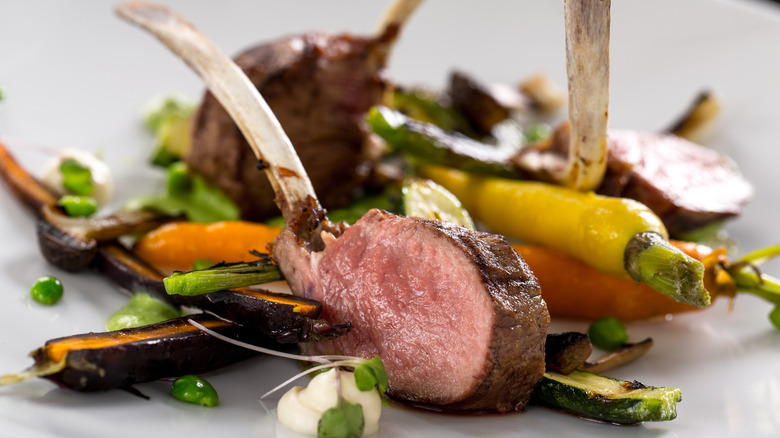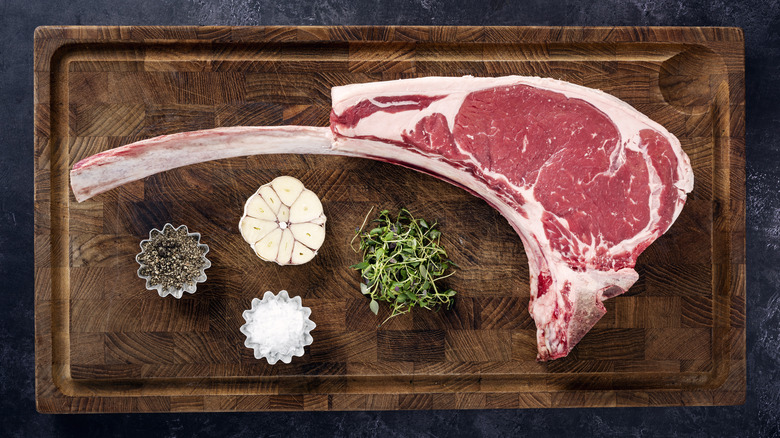What Ina Garten Asks Her Butcher While Ordering Lamb Chops
We may receive a commission on purchases made from links.
Lamb always makes a crowd-pleasing dinner, and lamb chops — although they can be expensive — feel extra special. Whether they're served simply grilled, or marinated in Indian spices and yogurt for homemade tandoori lamb chops, they're one of the most tender and tasty cuts.
Taken from the rib section, lamb chops can either be cooked individually or left together and cooked as a rack of lamb, then sliced before serving. While the bones are useful for picking the meat up and eating with your hands if so desired, they can sometimes look a bit messy on the plate. But Ina Garten has a top tip to help: Ask your butcher to French the lamb when you order it.
Frenched (also known as French trimmed) lamb means that any excess scraps of meat, as well as any fat, sinew, or cartilage, are trimmed away from the exposed bone before it is cooked, leaving the bone clean. And, as Garten explains in her "Cook Like a Pro" cookbook, it makes the finished dish look "more elegant."
Frenched lamb chops look prettier on the plate
Lamb rib chops (as opposed to lamb loin chops or shoulder chops) come as a rack, or double rack, consisting of tender chops attached to the rib bones. Frenching, or stripping the meat and any other bits from the bone to leave a couple of inches of clean exposed bone, can be done at home – or, as Ina Garten advises, you can simply ask your butcher to prepare it this way.
The advantages of Frenching the meat is all about how it looks, rather than about enhancing the taste or texture of the lamb chops in any way. Quite simply, the chops look more attractive when the bone is clean. And while it may seem wasteful to cut away any extra meat or fat, it's only really a very small amount, and these parts can often burn more easily than the main portion when cooked, anyway.
If you're a particular fan of nibbling the bones of your chops, then you may prefer not to French the meat, and may rather keep all the bits of fat or meat on the bones. It's really all about personal preference. But for a dinner party dish, such as Garten's panko-crusted rack of lamb, which is carved into either single or double chops before serving, it certainly does give the finished dish a professional touch.
Other types and cuts of meat can be frenched, too
It's not just lamb chops that can be French-trimmed. The technique can be used for other types and cuts of meat, too, such as pork, beef, or venison. Any piece of meat that has the bone attached can be trimmed to look more attractive, whether it's individual chops or rib roasts.
Ina Garten uses the method for her pork loin recipe — which, bought bone-in, can be Frenched and tied before cooking, and makes an impressive centerpiece when sliced between the bones to serve. And though bone-in steak isn't actually more flavorful than boneless, a tomahawk steak looks especially appealing when the huge exposed bone has been stripped. If you're worried about the waste when Frenching meat, then any trimmings could be kept and used for stocks or soups.
Historically, the exposed end of the bones of various types of meat may have been covered with chop frills — like tiny paper chef hats — though they are not commonly seen these days. But the meat doesn't need to be additionally dressed up when it looks as appetizing as it does when it's been Frenched. It's elegant enough as it is.



